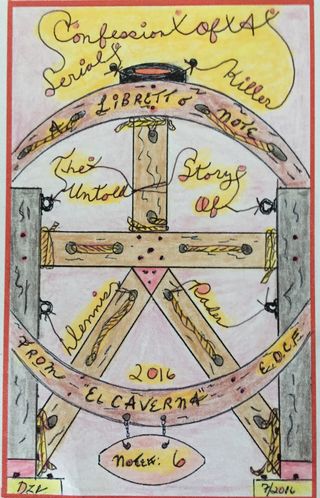Law and Crime
Art and the Serial Killer
Some offenders turn their prison sentence into creative expression.
Posted October 19, 2018

Recent news touted the creative talent of Rosemary West, who murdered young women with her husband in Britain. Her sponge cake won the prison bake-off. A few months ago, the Wichita Eagle ran an article that described bookplates that Dennis “B.T.K.” Rader drew for fans of his autobiography.
In fact, quite a few serial killers have developed their creative talents while in prison, from making origami or choker necklaces to painting serene sunsets. Most renowned, perhaps, is “Killer Clown” John Wayne Gacy, who murdered 33 young men and buried most in the crawlspace under his house. We often see his "Pogo the Clown" self-portraits on serial killer auction sites, along with his “Hi Ho” series of Disney characters.
Incarcerated offenders have time on their hands and some use art to express or enrich themselves. Regardless of whether they have talent, if they’re infamous, they attract buyers. Gacy was said to have made over $100,000 from his paintings, many of which went on display at “Killer” art shows.
Elmer Wayne Henley, who assisted “Candyman” Dean Corll with the brutal rape and murder of at least twenty-nine boys in Texas, says that art has calmed him and made him think about God. Thus, it elevates him. He likes to draw seascapes and surrealistic pictures (and he’s pretty good). Herbert Mullin, a California spree killer with psychotic delusions, has also painted landscapes, although he reportedly has no eye for perspective... or anything else. He still believes his 13 murders saved California.
Gary Gilmore showed such talent with sketching while in prison for armed robbery that he was granted conditional release. He was supposed to live in a halfway house and study art at a community college, but he never registered. Instead, he went back to crime. After more prison stints, he was released again and ended up killing two men.
Death row inmate Derrick Todd Lee, the “Baton Rouge Killer,” found a way to sell his art online. His pencil drawing of a pair of swans sold in one day. The couple who ran the website had discovered a rather lucrative occupation in selling art from killers. Among their customers, they said, were doctors, actors, attorneys, and soccer moms.
Massachusetts grappled with this issue in 2005 when sexual predator and serial killer Alfred Gaynor’s art turned up in an online auction. Gaynor was serving a life sentence for sodomizing and choking to death four women, and his pencil sketch of Jesus Christ kneeling – “A Righteous Man’s Reward” – provoked a fierce debate over his rights.
Not all states have laws that restrict such sales, but Rochester-based killer Arthur Shawcross came up against New York State’s policy against profit from murder when he attempted to sell artwork via outside associates. He was barred for five years from arts and crafts privileges.
“Celebrity” serial killers like Richard Ramirez, the Los Angeles “Night Stalker” (now deceased) maintain their reputations for being evil or bad by drawing devils, dismemberments, and stabbings. Gerard Schaefer, convicted of two 1970s murders but suspected in over 30, published a gruesomely illustrated collection of short stories. Police believe they amounted to a voyeuristic autobiography, a way to relive his actual crimes. Gainesville Ripper Danny Rolling also made violent drawings, mixing his fantasies with his shockingly brutal murders.
In Oregon, “Happy Face Killer” Keith Jesperson reproduced copyrighted photographs in pencil to make wildlife drawings. He sold them for $10 to $25 a piece, making about $1000. The prison superintendent brought him up for a disciplinary hearing and the photographer who owned the photos ordered Jesperson to cease and desist.
Online, there’s quite a collection of art from killers past and present, but the famous ones command the highest prices. Ottis Toole’s pencil sketches fetch more than Gary Heidnik’s, but art from Toole’s killing partner, Henry Lee Lucas, outshine both. The artifacts from newly convicted killers whose names are in the news might get a bump in value, but as they drift into obscurity, prices drop.
Plenty of collectors want to own such pieces, but many people find the display and acquisition of this art offensive, sensationalistic, and exploitive. They say it poisons the memory of the victims. Some even buy the art to destroy it. “What people have found so reprehensible about art produced by serial killers,” says true crime writer Harold Schechter, “is not the subject matter itself… What inspires such widespread disgust is the mere notion that convicted lust killers are allowed to be treated like minor celebrities.”
Most of the so-called artworks are no more than childish sketches, but here and there we've seen some talent. Whether one thinks that the creative streak that arises in killers should be stifled, encouraged or ignored, it’s hard to deny that within some of those whom we deem society’s worst, is the potential for imaginative skill and, yes, even beauty.
References
Ramsland, K. (2013). The care and feeding of serial killers. In Evil in American Pop Culture, Greenwood, Greenwood, CT: Prometheus.




